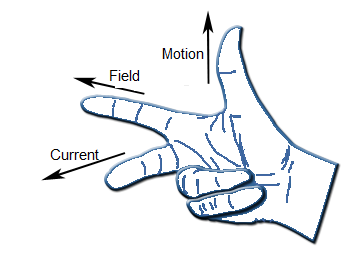
Which rule gives the direction of induced current due to electromagnetic induction?
A) Fleming’s left hand rule
B) Maxwell’s left hand rule
C) Ampere’s rule
D) Fleming’s right hand rule
Answer
501k+ views
Hint: The induced current due to the relative motion of a conductor in a magnetic field is perpendicular to the plane containing the directions of the magnetic field and the direction of the motion. This situation can be represented by the three outstretched fingers of a hand.
Complete answer:
The direction of the induced current when there is relative motion between a conductor in a magnetic field is perpendicular to the plane containing the direction of relative motion of the conductor and the magnetic field.
This direction can be very conveniently expressed using Fleming’s right hand rule. This rule states that if the thumb, index finger and middle finger of the right hand are outstretched in a mutually perpendicular fashion such that the thumb points towards the direction of the relative motion of the conductor and the index finger points towards the magnetic field, then the direction of the induced current is given by the direction of the outstretched middle finger.

So, the correct answer is “Option D”.
Note:
Students must not get confused between Fleming’s left hand rule and Fleming’s right hand rule. Fleming’s left hand rule is used for finding the directions of the motion for electric motors while Fleming’s right hand rule is used for finding the direction of the induced current in electric generators. If students use Fleming’s left hand rule in a place where they should have used Fleming’s right hand rule or vice versa, they will end up getting the opposite direction of the quantity that they wanted to find.
Complete answer:
The direction of the induced current when there is relative motion between a conductor in a magnetic field is perpendicular to the plane containing the direction of relative motion of the conductor and the magnetic field.
This direction can be very conveniently expressed using Fleming’s right hand rule. This rule states that if the thumb, index finger and middle finger of the right hand are outstretched in a mutually perpendicular fashion such that the thumb points towards the direction of the relative motion of the conductor and the index finger points towards the magnetic field, then the direction of the induced current is given by the direction of the outstretched middle finger.

So, the correct answer is “Option D”.
Note:
Students must not get confused between Fleming’s left hand rule and Fleming’s right hand rule. Fleming’s left hand rule is used for finding the directions of the motion for electric motors while Fleming’s right hand rule is used for finding the direction of the induced current in electric generators. If students use Fleming’s left hand rule in a place where they should have used Fleming’s right hand rule or vice versa, they will end up getting the opposite direction of the quantity that they wanted to find.
Recently Updated Pages
Master Class 4 Maths: Engaging Questions & Answers for Success

Master Class 4 English: Engaging Questions & Answers for Success

Master Class 4 Science: Engaging Questions & Answers for Success

Class 4 Question and Answer - Your Ultimate Solutions Guide

Master Class 11 Economics: Engaging Questions & Answers for Success

Master Class 11 Business Studies: Engaging Questions & Answers for Success

Trending doubts
Give 10 examples of unisexual and bisexual flowers

Draw a labelled sketch of the human eye class 12 physics CBSE

Differentiate between homogeneous and heterogeneous class 12 chemistry CBSE

a Tabulate the differences in the characteristics of class 12 chemistry CBSE

Why is the cell called the structural and functional class 12 biology CBSE

Differentiate between insitu conservation and exsitu class 12 biology CBSE




